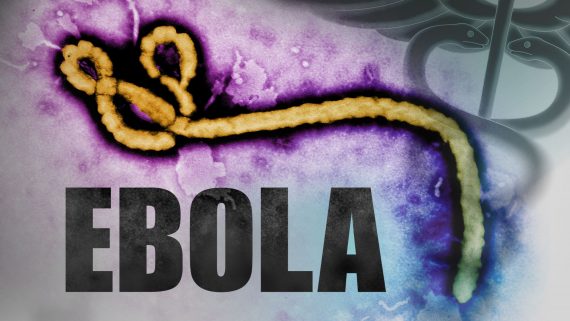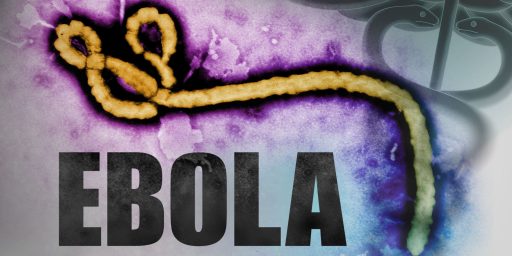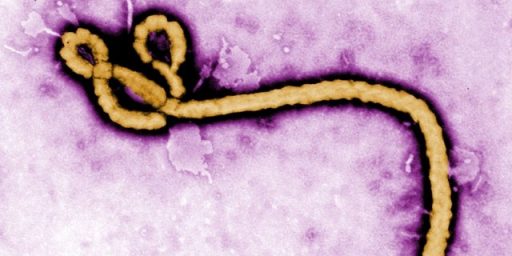Ebola Making A Reappearance In Africa
Ebola is making a reappearance in Central Africa.. Will the world be better prepared this time?

Several years after a widespread outbreak in East Africa that eventually made its way to Europe and the United States, it appears that the Ebola virus is making a reappearance in Africa:
Eleven new cases of hemorrhagic fever, including one death, have been reported since Tuesday in the Democratic Republic of Congo, Minister of Health Dr. Oly Ilunga said Thursday in Kinshasa. Two of those cases are confirmed to be Ebola. Lab results are pending on the other nine cases which are suspected to be Ebola.
Ebola virus disease, which most commonly affects people and nonhuman primates such as monkeys, gorillas and chimpanzees, is caused by one of five Ebola viruses. On average, about 50% of people who become ill with Ebola die.
The new outbreak was announced Tuesday. Sickness is occurring in the Bikoro health zone, 400 kilometers (about 250 miles) from Mbandaka, the capital of Equator province.
The World Health Organization reported Thursday that 27 total cases of fever with hemorrhagic symptoms were recorded in the Bikoro region between April 4 and May 5, including 17 deaths. Of these total cases, two tested positive for Ebola virus disease, according to the WHO.
The risk to public health is assessed as high at the local level, moderate at the regional level and low at the global level, according to the WHO.
The virus is transmitted to people from wild animals and spreads in the human population through human-to-human transmission. The affected area in Bikoro is remote, with limited communication and poor transportation infrastructure, the WHO said. Bikoro has a population of about 163,000 spread over an area of approximately 1,075 square kilometers (415 square miles).
On Tuesday, Ilunga requested support to strengthen the response to this outbreak. The ministry and the WHO have developed a plan to respond to the outbreak over the next three months. The full extent of the outbreak is not known, according to the WHO, and the location poses significant logistical challenges.
Three health care professionals are among the confirmed cases, Ilunga said: “As health professionals are the first actors in the government’s response to Ebola, this situation is of concern to us and requires a response that is all the more immediate and energetic.”
Ebola is endemic to the Democratic Republic of Congo, and this is the nation’s ninth outbreak of Ebola virus disease since the discovery of the virus in the country in 1976. The last outbreak occurred there in 2017 in the northern Bas Uele province. That outbreak was quickly contained due to joint efforts by the government, the WHO and other partners.
The London based newspaper The Star reports that nine countries in the area around the DRC have been advised of a potential threat:
World Health Organisation bosses have said they are preparing for the worst case scenario over the initial outbreak in a remote area of the Democratic Republic of Congo.
At least 17 people are reported to have been killed by the highly infectious virus.
The illness brought Africa to its knees earlier this decade - with more than 11,000 people being killed in an outbreak.
Nine neighbouring countries have now been warned of the potential spread of Ebola.
It comes after Ebola fears prompted emergency measures in Nigeria across the border.
WHO Deputy Director-General of Emergency Preparedness and Response Peter Salam made the announcement today.
He told a UN briefing in Geneva that he hoped the Democratic Republic of Congo would deploy an “experimental vaccine”.
The top doc warned however this was not a “magic bullet” and said they are preparing for the “worse case scenario”.
Nine countries surrounding the Congo include Angola, Zambia, Tanzaia, Uganda, South Sudan, the Central African Republic, the Republic of Congo, Rwanda and Burundi.
It was just four years ago, of course, that several nations in West Africa, including Guinea, Liberia, and Sierra Leone, experienced what remains the worst Ebola outbreak in known history, with some 11,000 people dead and more than 28,000 confirmed cases of the disease diagnosed before it was brought under control. This is also the second time that there have been reports of an Ebola outbreak in the DRC, a similar outbreak was reported last year and while it apparently did not wander outside the borders of that country it’s apparent that the outbreak was not fully contained.
The 2014 outbreak was notable, of course, because it marked the first time that the disease made an appearance in the First World since the virus was first identified forty-two years ago. That migration of the disease revealed rather starkly just how vulnerable a First World nation to a Third World disease like Ebola thanks to the transportation infrastructure that has developed since 1976 and which now connects large segments of the Third World to the United States, Europe, and beyond. It all began, of course, with the case of Timothy Eric Duncan, a Liberian citizen who became infected before flying to the United States, but didn’t display symptoms until long after he had left Liberia and successfully made it through the screening that health authorities there required all international travels to go through. Once arriving in the United States, Duncan was initially sent home from an Emergency Room in Dallas in part because medical personnel didn’t recognize the initial symptoms of Ebola and in part due to a communication breakdown between those personnel and the treating physicians on duty. He didn’t check into an American hospital again until it was far too late for him to be treated and ultimately, he passed away. While Duncan was being treated, though, he managed to infect two of the health care workers who treated him, Nina Pham and Amber Ray Vinson, both of whom underwent intensive treatment of their own that ended up being successful in both cases. Meanwhile, as the outbreak continued to devastate West Africa, several health workers who were infected with the virus were brought back to the United States for intensive treatment which successfully cured them of Ebola.
Here in the United States, the Ebola situation turned into a political issue when Dr. Craig Spencer, a doctor living in New York City who had been in West Africa helping to treat Ebola patients returned to New York City and started displaying symptoms of Ebola nearly a week later, at which time he was admitted for treatment and, ultimately, released after the virus was eradicated from his body. The prospect of someone with the Ebola virus roaming a major American city, combined with the fact that the United States was in the middle of an election year meant that there would be an inevitable political reaction. Restrictions were implemented at airports accepting flights from the area of the Ebola outbreak. That wasn’t enough for New Jersey Governor Chris Christie and New York Governor Andrew Cuomo, though, both of whom used their authority over the New York City area airports to impose far greater restrictions on people arriving from West Africa. This is led to the controversy involving a nurse named Kaci Hickox comes in and helped define the panicked, political response of many American politicians. Hickcox was detained at Newark Airport after arriving home from West Africa and not allowed to continue on to her connecting flight. Instead, she was taken into custody and in Newark, New Jersey before being allowed to return home to Maine. Once in Maine, that state’s Republican Governor Paul LePage, who just happened to be running for re-election, attempted to impose severe restrictions on Hickox’s liberty notwithstanding the fact that she displayed absolutely no symptoms of having the Ebola virus and that asymptomatic patients are not contagious. Governor LePage’s efforts were derailed by a Maine State Court Judge, who limited the requirements placed on Hickox to keeping local health authorities informed of her condition and location during the incubation period for the disease. Hickox has since filed a lawsuit against New Jersey Governor Chris Christie and the State of Maine over her detention in the Garden State and the conditions imposed on her when she returned home to Maine. Hickox ultimately settled her lawsuit with Maine, and the one filed against Christie. In the second case, the settlement included the adoption by the state of a “bill of rights” for patients held in quarantine under state law.
Hopefully, this outbreak will be as limited as the one last year, and the aforementioned vaccine should play a large role in the effort to bring it under control assuming that caregivers are aggressive enough in inoculating the general population. One hopeful sign is the fact that, thanks in no small part to what was learned by health professionals during the 2014 outbreak, we now have a vaccine that is as close to being 100% as seems medically possible. The key is to get that vaccine where it needs to be and making sure that people are inoculated in sufficient numbers to provide the kind of “herd immunity” that would prevent the outbreak from spreading. Nonetheless, it’s ironic that it comes at the same time that John Bolton, the President’s new National Security Adviser, has eliminated the White House’s Global Health Security Team. If the Ebola crisis taught us anything, it is that a prompt response to a disease such as this is essential to prevent it from spreading and to effectively treating it should it make its way to the United States. The fact that the Trump Administration doesn’t recognize that is worrisome albeit unsurprising.



Ebola in Central Africa is hardly news really – it’s there that there is a substantial wild reservoir and has been for decades.
The West African outbreak became so notable as it was new – relative to break out into general human population at least – and the West African systems (notably Liberia and Sierre Leone, along with Guinea Conaktry actually, as Senegal, Mali, Cote d’Ivoire proved perfectly capable of handling) were not ready.
In fact looking back one shouldn’t even call it a West African issue – it was really in the end the disaster driven by the dysfunction of two post-conflict countries, Liberia and Sierra Leone abetted in part by the weakness of the Guinea Conakry government vis-à-vis the inland backlands bordering Liberia and Sierra Leone.
Even dirt-poor but actually functional (government wise) Mali did not experience significant problems, while Senegal mastered its exposure better than the USA.
@lounsbury:
You make a good point, but the warning from the WHO does tend to raise a red flag with regard to this particular issue.
Nonetheless, this will be a good opportunity to test whether we’ve learned the lessons we should have learned from the 2014 outbreak.